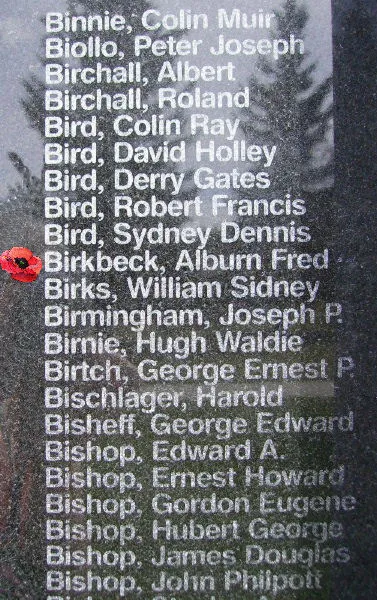Birkbeck, Alburn Fred (Flight Sergeant)
Killed in Action 1943-May-26


Birth Date: 1923
Born:
Parents: Son of Charles and Lizzie Birkbeck, of Welwyn, Saskatchewan, Canada.
Spouse:
Home: Welwyn, Saskatchewan
Enlistment:
Enlistment Date: unkown date
Service
RCAF
Unit
467 (B) Sqn- Squadron (RAAF)
Recidite Adversarius Atque Ferociter Your opponents will retreat because of your courageous attack
Base
RAF Bottesford
Rank
Flight Sergeant
Position
Air Gunner
Service Numbers
R/102142
Mission
Lancaster Mk.I/III ED695
Bombing Dusseldorf Germany 1943-May-26 to 1943-May-26
467 (B) Sqn (RAAF) RAF Bottesford, Lincolnshire, England
467 Australia Squadron. Target - Dusseldorf, Germany. Lancaster aircraft ED 695 lost whilst engaged in operations over enemy-held territory. RCAF member Flt. Sgt. A.F. Birkbeck and RAF member Pilot Officer K.R. Langhorne were killed. Five of the non-Canadian crew were taken Prisoner of War: Sgt's. R.A. Avann, S.G. Keirs, and W.V. Morris, Pilot Officer P.R. Collins, and Flying Officer R.S. Giddey. Giddy of Gordon, Australia, was the pilot of the aircraft and following is his report of the event. "On this night we had made our way to the target corkscrewing all the way over enemy territory, dropped our bombs then set course for base. Our flight plan called for us to corkscrew out from the target and back to the Dutch coast. When Pilot Officer Collins (Nav.) told us we were over the coast I straightened out and put the nose down into a steep dive thinking we were safe and out of range. It was then the night fighter got us. There was a terrific crash and we were on fire. As we were over the North Sea it would be useless to parachute so I gave orders for ditching and the crew members took their positions. The two gunners, Langhorne and Birkbeck were the only ones not to acknowledge my order which leads me to believe that they must have been killed by the first burst from the night fighter. The smoke and flames obscured the instrument panel and owing to the red glow inside the aircraft I could not distinguish the horizon. I was finally able to see a few houses and realized we had turned back to the Dutch coast. I lifted the nose then flattened out, cut the four engines and as we lost air speed I pulled the control column right back thus stalling the plane and causing it to hit tail first. The initial hit wasn't too bad but the second, when it finally came, was horrific. All five of the crew abandoned the aircraft and took refuge in a barn. We eventually left the area, one at a time, but were captured very soon after. I was free the longest as I didn't get captured until August 8, 1943."Lancaster serial: ED695

Canadian Warplane Heritage Museum
The Avro Lancaster is a British Second World War heavy bomber. It was designed and manufactured by Avro as a contemporary of the Handley Page Halifax, both bombers having been developed to the same specification, as well as the Short Stirling, all three aircraft being four-engined heavy bombers adopted by the Royal Air Force (RAF) during the same wartime era.
The Lancaster has its origins in the twin-engine Avro Manchester which had been developed during the late 1930s in response to the Air Ministry Specification P.13/36 for a capable medium bomber for "world-wide use". Originally developed as an evolution of the Manchester (which had proved troublesome in service and was retired in 1942), the Lancaster was designed by Roy Chadwick and powered by four Rolls-Royce Merlins and in one version, Bristol Hercules engines. It first saw service with RAF Bomber Command in 1942 and as the strategic bombing offensive over Europe gathered momentum, it was the main aircraft for the night-time bombing campaigns that followed. As increasing numbers of the type were produced, it became the principal heavy bomber used by the RAF, the Royal Canadian Air Force (RCAF) and squadrons from other Commonwealth and European countries serving within the RAF, overshadowing the Halifax and Stirling. Wikipedia